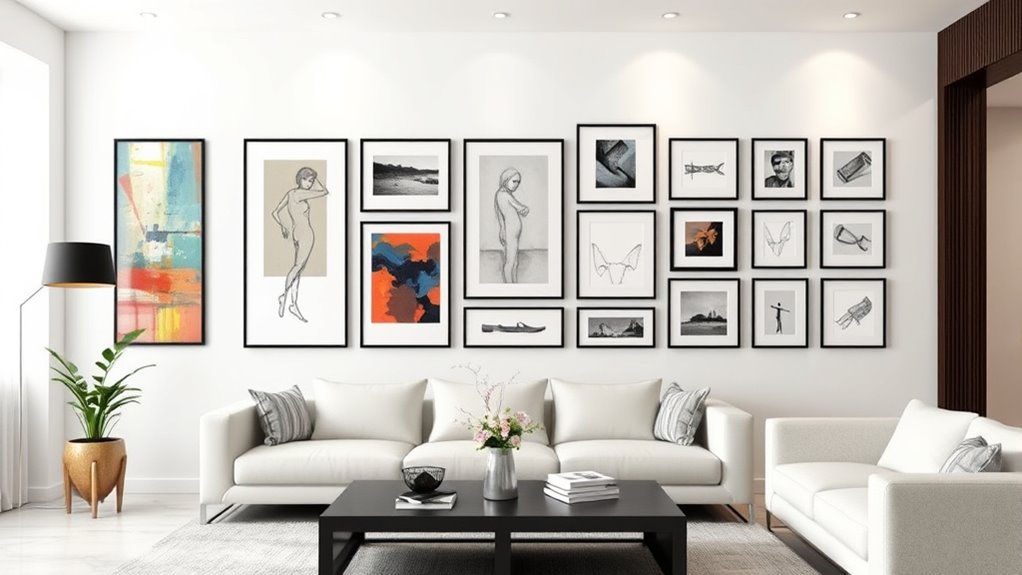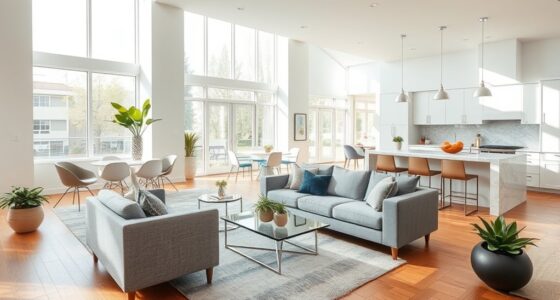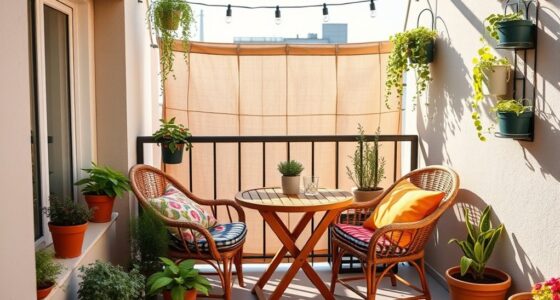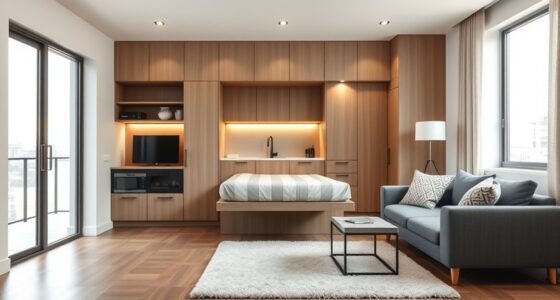To arrange art in gallery walls with effective spacing and symmetry, start by planning your layout with painter’s tape or paper templates to experiment with spacing and alignment. Maintain consistent gaps between frames for a organized look or vary spacing intentionally for a more eclectic vibe. Use symmetry around focal points for a polished feel, or opt for asymmetry to create a modern look while keeping visual balance. Continuing will help you master creating stunning displays.
Key Takeaways
- Use painter’s tape or paper templates to plan and experiment with layout before hanging artwork.
- Maintain consistent spacing between pieces for a clean, organized appearance; vary spacing intentionally for an eclectic look.
- Symmetrical arrangements create order and sophistication, especially around focal points or central pieces.
- Asymmetrical layouts add a modern, relaxed vibe; ensure visual balance despite uneven spacing.
- Consider overall visual harmony by matching frame styles and colors to unify diverse artworks.

Have you ever wondered how to create a striking gallery wall that seamlessly showcases your favorite art? The key lies in understanding how frame styles and color coordination can transform a collection of individual pieces into a cohesive, eye-catching display. When choosing frame styles, consider mixing materials like sleek metal, rustic wood, or ornate vintage designs to add visual interest. However, it’s vital to balance variety with harmony. For example, pairing different frame styles that share a common color or finish helps create unity, so your gallery wall doesn’t look cluttered or chaotic. If you prefer a more uniform look, sticking to similar frames in matching colors can produce a polished, streamlined effect. Conversely, mixing contrasting frame styles can add personality and depth if you pay attention to color coordination; selecting frames in complementary hues or shades that tie into your artwork ensures everything feels intentional rather than disjointed.
Next, think about how color coordination plays a pivotal role in the overall aesthetic. Your artwork and frames should work together to create a harmonious palette. If your art features vibrant, bold colors, consider framing with neutral tones like black, white, or natural wood to let the art stand out. On the other hand, if your pieces are more subdued or monochromatic, adding frames in richer, contrasting colors can elevate the display and add visual interest. You don’t have to match every element perfectly; instead, aim for a balanced interplay of tones that tie the gallery wall together. For example, if most of your artwork contains blues and greens, selecting frames in similar shades or in complementary colors like warm browns can create a cohesive look. Remember, the goal is to make each piece feel connected without overwhelming the eye. Additionally, understanding the importance of visual harmony can help you make informed choices that enhance your overall display. When arranging your gallery wall, pay close attention to spacing and symmetry. Consistent spacing between frames creates a clean, organized appearance, while varying the distances can lend a more dynamic, eclectic vibe—just be sure to keep it intentional. Symmetry often lends a sense of order and sophistication, especially when centered around a focal piece, but asymmetrical arrangements can feel more relaxed and modern. Whichever approach you choose, maintaining visual balance is vital. Use painter’s tape or paper templates to experiment with different layouts before committing to nails or hooks. This way, you can see how frame styles and colors work in relation to each other while adjusting spacing to achieve the perfect balance. Ultimately, your gallery wall should reflect your personality and style, with thoughtful choices in frame styles, color coordination, and spacing creating a stunning display that feels both curated and personal.
Frequently Asked Questions
How Do I Choose a Unifying Theme for My Gallery Wall?
To choose a unifying theme for your gallery wall, start by identifying a common element like color coordination or a shared subject matter. You might select artwork with complementary hues or focus on a specific theme, such as nature or travel. Keep the overall style consistent, whether modern or vintage, to guarantee thematic consistency. This approach creates a cohesive look that ties all your pieces together beautifully.
What Are the Best Tools for Measuring Spacing Accurately?
Oh, the thrill of precise measurement—who knew it could be so exhilarating? Grab a trusty measuring tape for pinpoint accuracy and use painter’s tape to mark your spots on the wall. This clever duo guarantees perfect spacing without guesswork, turning chaos into harmony. With these tools, you’ll avoid awkward gaps and crooked frames, transforming your gallery wall into an artful masterpiece that’s as flawless as your eye for design.
How Can I Incorporate Different Frame Styles Harmoniously?
You can incorporate different frame styles harmoniously by matching frame finishes, like combining black matte and gold accents for cohesion. Mix frame shapes—such as rectangles and circles—to add visual interest but keep the overall color palette consistent. Use similar matting or spacing to unify diverse frames, and balance large and small pieces thoughtfully. This approach creates an eclectic yet harmonious gallery wall that feels intentional and stylish.
What Should I Do if Artwork Sizes Vary Significantly?
When you have artwork sizes that vary considerably, start by grouping similar sizes together to create visual balance. Use layout adjustment techniques, like spacing smaller pieces closer and giving larger pieces more breathing room, to achieve harmony. You can also align the centers of your artwork or create a grid with intentional gaps. This approach guarantees your gallery wall looks cohesive despite size differences, making it both dynamic and well-organized.
How Often Should I Update or Rotate Gallery Wall Pieces?
Sure, you should rotate your artwork seasonally or whenever your taste changes—no need to be stuck with the same pieces forever. Think of your gallery wall as a living, breathing art exhibit. Swap out pieces during seasonal updates to keep things fresh and exciting. Regularly rotating artwork keeps your space lively and engaging, making sure your walls always reflect your evolving style and mood.
Conclusion
Now that you know the secrets to spacing and symmetry, your gallery wall will become a living masterpiece that tells your story. Think of it as a dance where every piece finds its perfect rhythm, creating harmony in your space. Trust your eye and don’t be afraid to experiment—your unique touch is what makes your wall truly special. With patience and passion, you’ll turn blank walls into a mesmerizing gallery that feels like a warm hug.









